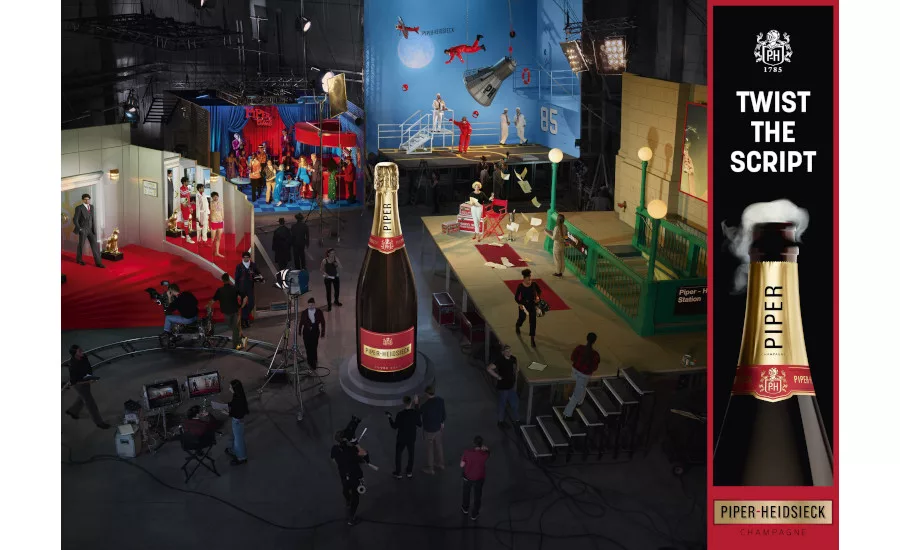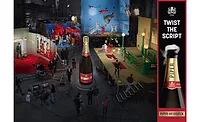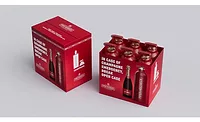Piper-Heidsieck honors tradition, embraces innovation
Vice president of marketing for Champagne brand talks portfolio, marketing

Image courtesy of Piper-Heidsieck

Harmonizing about the good life, Ne-Yo sings “Livin’ this Champagne life, everything’s okay / Let’s toast it up,” in the 2010 song “Champagne Life.” But R&B artists are not the only ones who will be toasting it up this National Champagne Day (Dec. 31).
Ahead of National Champagne Day, Beverage Industry chatted with Geraud Leclercq, vice president of marketing at Folio Wines, which oversees the Piper-Heidsieck, Reims, France, portfolio.
“For us, [National] Champagne Day is every day,” he says. “That said, National Champagne Day is a perfect moment to spotlight the joy and versatility of our wines. It’s about encouraging Champagne lovers to savor moments big and small, reinforcing that Piper-Heidsieck is the perfect companion for every toast — on National Champagne Day and beyond.”
A market overview
This comes as the wine varietal has seen increasing competition from other types beverage alcohol. Leclercq describes the current Champagne market in the United States as “facing significant headwinds,” with overall sales down compared with last year. However, that has not put a damper on Piper-Heidsieck.
“Despite this, Piper-Heidsieck is consistently outperforming the category and is gaining market share as the year progresses, delivering a solid 10% sales growth over last year in H2, while the category has remained in negative territory,” he says. “The House now ranks as the No. 4 Champagne brand in the U.S. by sales volume.”
Leclercq points to recent data from the Chicago-based Circana. He notes what trends have contributed to the Champagne market performance.
“Piper-Heidsieck has experienced strong growth in both on-premise and independent retail channels, driven by a focus on premium offerings,” Leclercq explains. “The continued expansion of the Essentiel tier has been a key contributor, particularly with the introduction of Essentiel Blanc de Noirs — a blend of Pinot Noir and Meunier — late last year. This release has been exceptionally well-received in high-end restaurants, bars and exclusive events, further solidifying the brand’s position in the luxury Champagne segment.”
Piper-Heidsieck has been awarded more than 275 medals and accolades, Leclercq notes. It also has been one of the U.S. market’s Top 5 Champagne brands for more than a decade.
“This success stems from the House’s unwavering commitment to wine excellence, consistently delivering exceptional quality and value that resonates with both gift buyers and everyday wine enthusiasts,” he adds.
Embracing tradition and innovation
To produce this type of success the vice president of marketing explains it comes from balancing heritage with novelty.
“Piper-Heidsieck celebrates the rich traditions of its vineyard while embracing innovative practices that challenge the conventional boundaries of Champagne making,” Leclercq says. “At the heart of our identity lies our emblematic grape variety. Pinot Noir, often associated with powerful and structured wines in Champagne, is reimagined at Piper-Heidsieck to highlight its vibrancy and minerality.”
This approach produces vertical and elegant wines, he explains, which is exemplified by the brand’s Essentiel Blanc de Noirs.
“Our concept of a prestige cuvée also breaks tradition,” Leclercq notes. “Instead of a classic, vintage prestige cuvée, we’ve introduces the Hors-Série collection — a series of exclusive, limited-edition, and unconventional wines from Champagne.”
Following the reinterpretation of two oenothèque vintages, 1971 and 1982, Leclercq says the brand has “pushed the boundaries further” with its newly launched Hors-Série Coteaux Champenois 2022.
“This bold, still white wine, crafted from Pinot Noir, utilizes only stainless-steel vats and features a screw cap to preserve the pure expression of two Grands Crus terroirs,” he shares. “It’s a daring move that challenges norms and redefines expectations.”
Leclercq also says that Piper-Heidsieck is “deeply committed” to adapting to climate change, while still maintaining the brand’s signature style.
“This includes exploring cooler terroirs, re-evaluating the role of Meunier in our blends and more frequently blocking malolactic fermentation to preserve the vibrant character of our wines,” he explains. “Our unique philosophy extends to the tasting process, where impartiality is key. Eight winemakers from our tasting panel, evaluating wines through blind tastings.”
This process ensures that decisions are guided solely by the quality and style of the wine, Leclercq says, irrespective of Cru, terroir or grape origin.
Shaking things up
Earlier this year, Piper-Heidsieck launched a new global campaign called Twist the Script. The campaign featured vibrant artwork from renowned British artist and photographer Miles Aldridge.
“The brand’s joyful disobedience gave me the creative freedom to explore its unique history,” Aldridge said in a statement at the time of the launch. “Reimagining these iconic moments has been a fantastic way to capture Piper-Heidsieck’s bold and cinematic essence.”
The campaign highlighted four key moments from the brand’s past, all interpreted by Aldridge.
“Twist the Script underscores Piper-Heidsieck’s commitment to doing things differently,” Leclercq says. “From appointing the 31-year-old Chef de Caves, Émilien Boutillat, in 2018, who brought with him an innovative approach to winemaking — a daring move in an industry that values tradition — to becoming the first Champagne house to achieve B Corp certification for its sustainability efforts, Piper-Heidsieck continues to blaze its own trail.”
Leclercq notes that the campaign reflects pivotal moments in the brand’s history and emphasizes its forward-thinking approach to winemaking and innovation.
“The brand has always found a way to ‘twist the script’ to continue to drive innovation and keep up with technologically advanced standard in winemaking,” he adds. “Piper-Heidsieck has broken barriers on the technical, oenological and viticultural levels throughout history. Innovation does not mean forgetting history and tradition, it is about finding a balance between the two.”
Aside from the Twist the Script campaign, Piper-Heidsieck proudly supported many charitable, cultural and sporting activities in the United States over the past year. Notably, the Miami Open, Tribeca Film Festival, New York Film Festival, PFLAG partnership and the amfAR Gala in Palm Beach.
The Champagne house also noted plans to invest in cutting-edge technologies, such as robotics for sustainable viticulture.
“We have set several objectives for sustainability, and the first milestones will be in 2025 and 2030,” Leclercq says. “One of the first steps is to renew our B Corp certification in 2025. This certification encourages us to innovate and constantly rethink how we operate across all CSR pillars.
“We set up mid-term and long-term objectives regarding many other topics: sustainable certification for our partners in the vineyards, biodiversity, reduction of waste, water and energy consumption,” he continues. “Regarding our climate strategy, 2030 is an important milestone, as we are committed to reducing our carbon footprint by 42% per bottle in intensity for Scope 3 and -61% in absolute for Scopes 1&2 (compared to 2019).”
The long-term commitment, Leclercq shares, is set for 2050, with the ambition to be part of the Net-0 Carbon emissions globally.
“To achieve this, we’re leading with experimentation through what we call ‘The Piper Lab,’ where we explore organic farming, viti-forestry and cover crops to eliminate herbicides and reduce tilling,” he explains. “We have also planted 0.5 hectares of VOLTIS as part of large-scale experimentation to explore new sustainable practices. We were among the first two Champagne houses to invest in VITIBOT and its autonomous vineyard robot, BAKUS, pioneering sustainable viticulture with cutting-edge technology.”
Looking for a reprint of this article?
From high-res PDFs to custom plaques, order your copy today!









